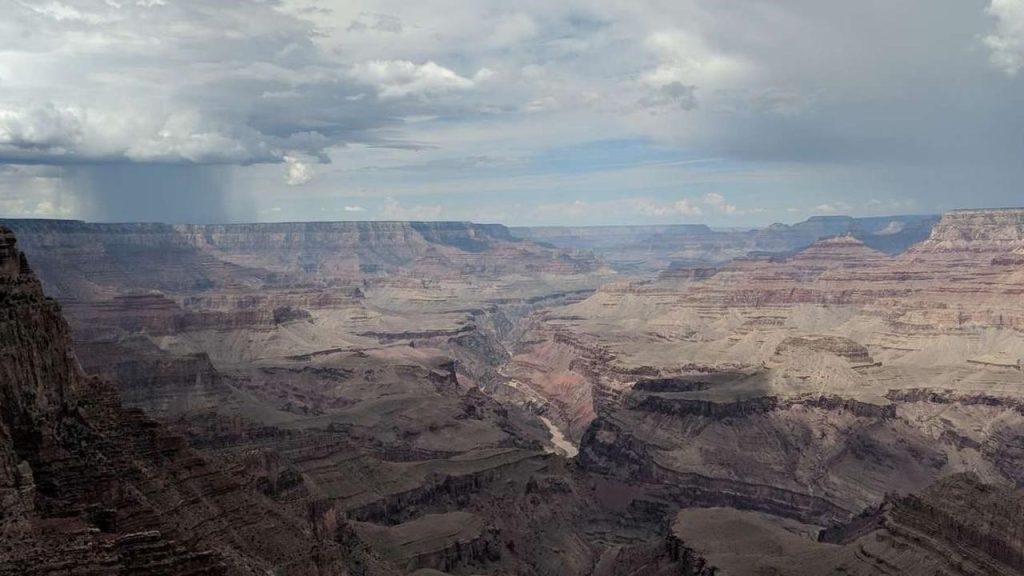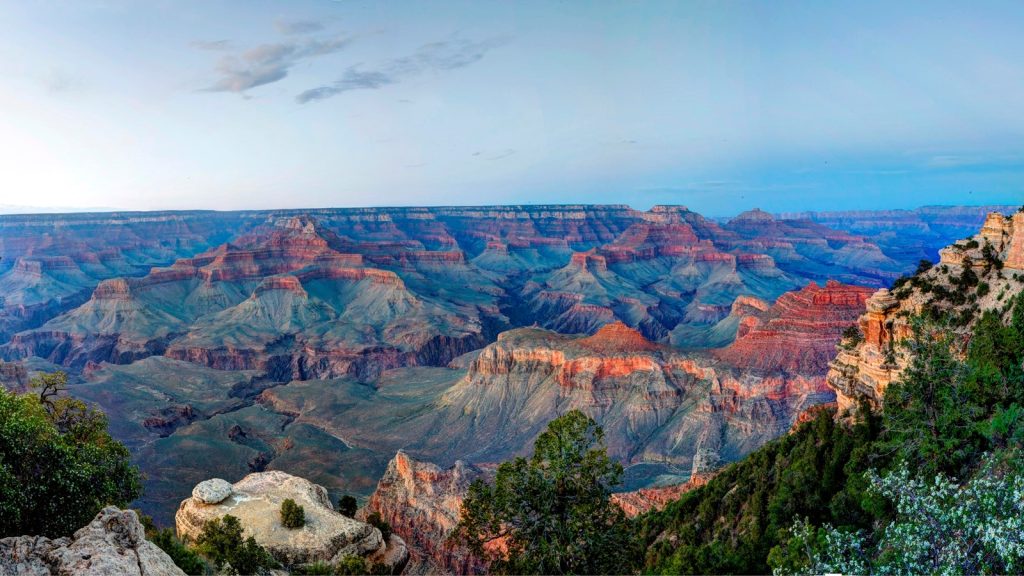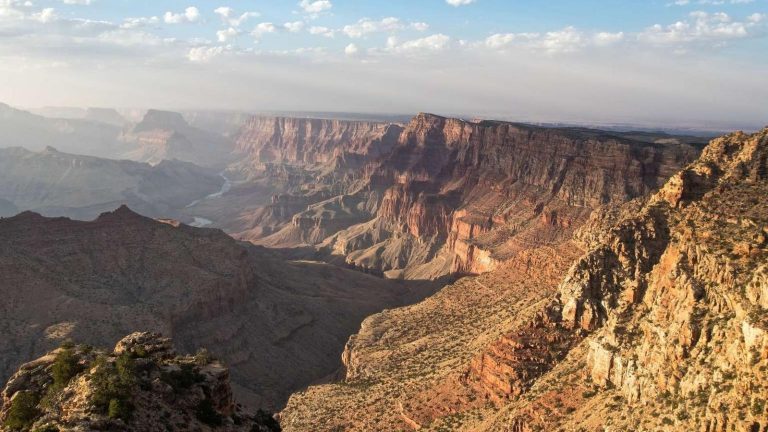Introduction to the Grand Canyon

The Grand Canyon is a natural wonder that stretches 277 miles and is up to 18 miles wide. It was formed over millions of years by the Colorado River, which carved its way through the rock and created the canyon. The Grand Canyon is a unique and diverse ecosystem that is home to a wide variety of plants and animals. It is also a sacred place for many Native American tribes who have lived in the area for thousands of years.
The Grand Canyon is a popular tourist destination, attracting millions of visitors each year. It is a place of wonder and inspiration, and many people come to the Grand Canyon to find peace and quiet.
History of the Desert View Drive
The Desert View Drive was built in the early 1900s by the Santa Fe Railroad to provide access to the South Rim of the Grand Canyon. It was originally a dirt road, but it was paved in the 1930s to accommodate the growing number of visitors to the Grand Canyon. The drive is named after the Desert View Watchtower, which was built in 1932 by Mary Colter, a renowned architect who designed many buildings at the Grand Canyon.
Planning Your Trip to the Grand Canyon
Before embarking on your journey to the Grand Canyon, it’s essential to plan your trip to ensure you have a safe and enjoyable experience. There are several things you need to consider, such as when to go, where to stay, and what to pack.
The best time to visit the Grand Canyon is in the spring or fall when the weather is mild, and the crowds are smaller. Summer can be hot and crowded, and winter can be snowy and icy, making it difficult to explore the park. You’ll want to check the weather forecast before you go and bring appropriate clothing for the season.
When it comes to lodging, there are several options available, including campgrounds, cabins, and hotels. If you plan on staying inside the park, you’ll need to make reservations in advance, as accommodations fill up quickly, especially during peak season.
When planning your trip, it’s also important to consider your transportation. If you’re flying into the area, you can rent a car at the airport or take a shuttle to the park. Once you’re inside the park, you can take the park shuttle, which runs along the South Rim and connects to various points of interest.
What to Pack for the Desert View Drive
When packing for your trip to the Grand Canyon, you’ll want to bring essential items such as comfortable walking shoes, a hat, sunscreen, and a water bottle. It’s also a good idea to bring a camera to capture the stunning views of the canyon.
If you plan on hiking or camping, you’ll need to bring additional gear such as a tent, sleeping bag, and cooking supplies. It’s important to pack lightweight and compact items that won’t take up too much space in your luggage.
Safety Tips for the Desert View Drive
The Grand Canyon is a beautiful and awe-inspiring place, but it can also be dangerous if you’re not careful. It’s essential to follow safety guidelines to ensure you have a safe and enjoyable trip.
Some safety tips to keep in mind include staying on designated trails, avoiding getting too close to the edge of the canyon, and not feeding wildlife. It’s also important to bring plenty of water and snacks and to avoid hiking during the hottest part of the day.
Before starting your journey on the Desert View Drive, make sure your vehicle is in good working condition, and you have enough gas to get to your destination. It’s also a good idea to let someone know where you’re going and when you expect to return.
Best Time to Visit the Grand Canyon
The best time to visit the Grand Canyon depends on what you want to see and do. The peak season for the Grand Canyon is during the summer months, but the park can be crowded and hot. The shoulder seasons of spring and fall offer cooler temperatures, smaller crowds, and beautiful foliage.
Winter can also be a great time to visit the Grand Canyon, with smaller crowds and opportunities for winter activities such as snowshoeing and cross-country skiing. However, some parts of the park may be closed or inaccessible due to snow and ice.
It’s important to note that the North Rim of the Grand Canyon is closed during the winter months due to heavy snowfall, and it typically reopens in mid-May.
Starting Your Journey on the Desert View Drive
The Desert View Drive begins at the South Rim of the Grand Canyon and runs 25 miles to the Desert View Watchtower. Along the way, there are several viewpoints to stop at and take in the breathtaking views of the canyon.

The Desert View Watchtower
The first stop on the Desert View Drive is the Watchtower. The Watchtower is a 70-foot tower that was designed by architect Mary Colter in 1932. The tower was modeled after ancient Anasazi watchtowers and is a popular stop for visitors to the Grand Canyon.
Inside the tower, there are several floors with exhibits on the history and culture of the Grand Canyon. The top of the tower offers panoramic views of the canyon, making it a great spot to take in the scenery.
When you start at the main Desert View parking area, a short walk of .25 miles (.4 km) takes you past restrooms, a general store/market, and a trading post. You can see the Watchtower from there.
Desert View is the eastern-most part of the South Rim of the park. The Watchtower was built in 1932 and is recognized as a National Historic Landmark. The architect, Mary Colter, based her design on the architecture of the Ancestral Puebloan people of the Colorado Plateau. She patterned this tower after the ones found at Hovenweep and the Round Tower of Mesa Verde. Colter said it was not a copy of any tower she had seen but was modeled from several.
The Watchtower provides a different view of the eastern part of Grand Canyon. When you look northeast from there, you can see the Colorado River, which is narrow in Marble Canyon, becoming wider and broader as it enters Grand Canyon.
Navajo Point

The next stop on the Desert View Drive is Navajo Point. Navajo Point is a high point on the South Rim that offers stunning views of the canyon. From Navajo Point, you can see the Colorado River winding through the canyon and the Painted Desert in the distance.
There is a small parking area at Navajo Point, and a short walk takes you to the viewpoint. Navajo Point is a great place to watch the sunrise or sunset, and it’s a popular spot for photographers.
Lipan Point

Lipan Point is another scenic viewpoint along the Desert View Drive. It’s named after the Lipan Apache tribe, who once lived in the area. Lipan Point offers sweeping views of the canyon, including the Eastern Rim, the Colorado River, and the Unkar Delta.
Lipan Point is a popular spot for watching the sunset, and there are several benches and picnic tables for visitors to enjoy the view. The Lipan Point Trail is a short hiking trail that leads to a more secluded viewpoint and is a great spot to escape the crowds.
Lipan Point offers one of the most stunning canyon views along the South Rim, with the added bonus of the longest perspective of the Colorado River. The spot is perfect for experiencing the sunrise, sunset, and night sky.
If the weather is clear, one can view the Vermillion Cliffs, which are situated 45 miles (72 km) to the northeast, and the winding river to the west as it enters the Inner Gorge of the canyon.
The spacious panoramic view boasts various spires, buttes, and temple formations that resemble ancient pyramids. The view westward seems to extend infinitely, and the canyon walls present an array of colors ranging from black, gray, red, brown, to tan, exhibiting a variety of rough and smooth textures.
At this spot, one can look down at the base of the canyon and witness the grandeur of the Colorado River and the tilted layers of the Grand Canyon Supergroup. These unique rocks are only exposed in a few areas within the canyon and visible from only a few viewpoints. Unkar Delta, nestled among the titled layers and surrounded by the river, is where ancient Puebloan civilization once cultivated beans, corn, and squash.
Take a moment to listen for the deafening roar of Hance Rapid, located almost four miles (6.4 km) away, and for the cries of hawks and other raptors along this important migration route. The forests on this side of the canyon and the North Rim, just eight miles (13 km) away, make Lipan Point a perfect spot for birds crossing the canyon.
Moran Point
Moran Point is a less-visited viewpoint along the Desert View Drive, but it offers some of the best views of the canyon. From Moran Point, you can see the Colorado River, the Temple of Vishnu, and the Bright Angel Trail.
The viewpoint is named after a prominent artist, Thomas Moran, known for his exquisite landscape paintings of the western United States. His exceptional artistry contributed significantly to the creation of numerous national parks. Visit this point to discover a great spot for watching the shadows and the interplay of light that evolves throughout the day, much like the artist himself would have done.
There is a small parking area at Moran Point, and a short walk takes you to the viewpoint. Moran Point is a great spot to watch the sunrise or sunset, and it’s a peaceful place to escape the crowds.
Grandview Point

Grandview Point is one of the oldest and most historic viewpoints along the Desert View Drive. It was named after a miner named Pete Berry who discovered a rich vein of copper in the area in the late 1800s.
From Grandview Point, you can see the canyon stretching out for miles, including the Colorado River and the Phantom Ranch. Grandview Point is also a great place to see the layers of rock that make up the canyon and to learn about the history of mining in the area.
There is a small parking area at Grandview Point, and a short walk takes you to the viewpoint. Grandview Point is a popular spot for watching the sunrise, and it’s a great place to escape the crowds and enjoy the beauty of the canyon.
Yaki Point

Yaki Point is a popular viewpoint along the Desert View Drive that offers stunning views of the canyon. From Yaki Point, you can see the Colorado River, the South Kaibab Trail, and the O’Neill Butte.
Yaki Point is a popular spot for watching the sunrise and sunset, and there are several benches and picnic tables for visitors to enjoy the view. Yaki Point is also a great place to learn about the geology of the canyon and to see the different layers of rock that make up the canyon.
Here the view of the canyon opens up to the east, with the Desert View Watchtower visible in the distance.
There is no parking at Yaki Point, and visitors must take the park shuttle or walk to the viewpoint. Yaki Point is also the starting point for several hiking trails, including the South Kaibab Trail and the Bright Angel Trail.
Tusayan Ruin and Museum

The Tusayan Ruin and Museum is a historic site along the Desert View Drive that offers a glimpse into the lives of the ancient Pueblo people who once lived in the area. The museum features exhibits on the history and culture of the Pueblo people, and the ruins offer a look at the ancient structures they built.
The Tusayan Ruin and Museum is a great place to learn about the history of the Grand Canyon and to see the unique architecture of the Pueblo people. It’s also a peaceful place to escape the crowds and enjoy the beauty of the canyon.
Ending Your Journey on the Desert View Drive
The Desert View Drive ends at the Desert View Watchtower, where you can take in one last view of the canyon before leaving the park. The Desert View Watchtower offers stunning views of the canyon, as well as exhibits on the history and culture of the area.
After visiting the Desert View Watchtower, you can explore the nearby gift shop and restaurant before leaving the park.
The Desert View Drive is a memorable journey that offers breathtaking views of the Grand Canyon and a glimpse into the history and culture of the area.
